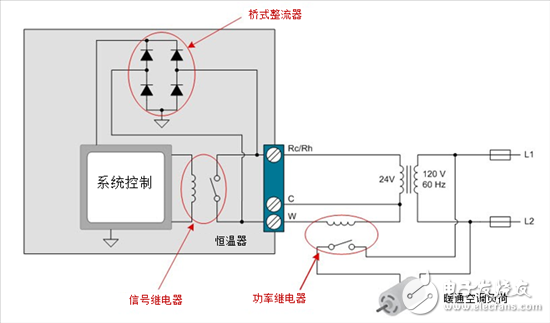Co-authored by Miro Oljaca and TatTIana Davenport
If you read how a thermostat interacts with a HVAC system in my previous post "Hey! Hey! What's wrong with your thermostat?", you will know how the thermostat works. Control HVAC load. But where does the thermostat get the operating power and how do you make it more efficient?
There are two types of power supplies available for the thermostat: Battery and 24VAC power supply. The thermostat requires battery power to operate without interruption. It is very important that the energy consumed by these batteries is as low as possible, but even if you minimize the power consumption, the user still feels inconvenient to use because the battery needs to be replaced from time to time. To reduce the frequency of replacement, you can use a 24 VAC power supply. When the C line is not available in the system, the bridge rectifier shown in Figure 1 can convert the alternating current (AC) voltage into a direct current (DC) voltage by load.

Figure 1: Single thermostat signal relay connection with HVAC load
During the shutdown of the HVAC load (compressor, fan, gas valve, etc.), the contacts of the signal relay are disconnected. When the contacts open, the terminals of the rectifier bridge see the HVAC transformer voltage at 24VAC and convert the AC power to DC power as previously described. The DC voltage thus obtained is used to drive a thermostat or sub-circuit.
During the conduction of the HVAC load, the contacts of the signal relay are closed. When the contact is closed, the voltage across the rectifier bridge terminal drops to zero. This eliminates the need to use 24VAC as a power source, so the battery power of the thermostat must control the circuit. The current required to operate an electromechanical relay ranges from tens to hundreds of milliamps, which can have a significant impact on battery life.
What if there is a way to drive the relay without using the thermostat's battery? Battery life will increase and the frequency of replacement will be further reduced. One method is to briefly turn on the relay and charge the control system during the on-time of the HVAC load (signal relay contacts are closed). Compared to the turn-off time of the power relay, the time required during charging needs to be very short, which excites the power relay and its corresponding load. Unfortunately, electromechanical (signal) relays are unlikely to achieve this due to their switching speed limitations. The time it takes for the contact to move to the desired position is in the millisecond range and will interrupt the HVAC load operation.
Fortunately, there is a device that can achieve the right switching speed: Solid State Relay (SSR). The SSR is a semiconductor-based repeater that performs on/off control using a thyristor or a power transistor.
This recharging method requires an SSR with a dual MOSFET structure because it turns off the MOSFET-based SSR when necessary. In addition, the body diode of each MOSFET can assist in 24VAC rectification. A full-wave rectifier bridge is built by combining the MOSFET body diodes of two additional diodes, as shown in Figure 2.

Figure 2: Power supply for an SSR in an HVAC system
Figure 3 shows the rectified waveform obtained corresponding to the color-coded diode of Figure 2. Connecting a properly sized capacitor at the output of the rectifier bridge eliminates the voltage ripple of the final waveform. You can then reduce the DC voltage of the control system to the desired voltage.
Figure 3: Full-wave rectified waveform
The use of SSR allows the HVAC system to fully power the thermostat, reducing battery power usage. When the SSR is turned off, the HV1 and HV2 lines will see full 24VAC and provide a constant 33VDC at the output of the rectifier bridge. When the SSR is turned on, it may still cycle through the short-time on/off state to charge the power supply capacitor again. This design greatly reduces the energy requirements of the thermostat battery, which in turn reduces the frequency of battery replacement.
Want to know the component selection process for SSR in a thermostat terminal? Stay tuned for another blog post where I will outline a low-cost SSR design.
other information:
Learn about SSR in Bowen's "Modern Approach to Solid State Relay Design."
Download Solid State Relay 24V AC Switch with Galvanic Isolation Reference Design (TIDA-00751)
View these data sheets:
NexFETTM Power MOSFET CSD19537Q3.
FemtoFET ​​MOSFET CSD18541F5.
Street Light Post,Solar Street Lights With Pole,Solar Street Lamp Post,Solar Powered Street Lamp Post
NANTONG RONGCHANG IMPORT&EXPORT CO.,LTD , https://www.ergsolarcn.com